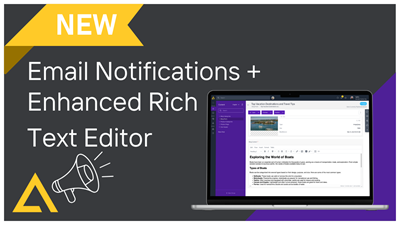11 Proven Methods To Improve Content Engagement For Your Business
Drive content engagement with these marketing tips


If you’re running a business, you should not just aim for a content to fill your website. Your content must be engaging, useful, and relevant. That’s the only way leads will reach out to you. And the more leads you have, the more potential customers you have.
Driving content engagement is not as easy as it sounds, though. You need to be strategic in the way you write and in your choice of topics. To get people to interact with your content, you need to understand your audience and their needs. Couple all this with good content architecture that ensures an excellent user experience, and you’re good to go.
In this article, let’s look at eleven ways to improve content engagement for your business. Ready? Let’s dive in.
1 Understand the Motive for Creating Your Content
Before anything else, you should understand what motivates you to write a specific piece of content. Understanding that will help you determine how you will go about writing it. For example, if you want the work to entertain, it would be best to use a light and fun tone. If you wish to provide content marketing tips, then a professional-sounding piece filled with actionable advice is your best bet.
Here are a few other types of content you might write, based on your motivation:
- Personal success stories: Write these if you have a reason to share your personal experiences.
- Data-driven pieces: These are pieces filled with hard facts that inform and educate.
- Reviews: If you want to share your opinion on a recently used product, reviews are the way to go
Your motivation for writing should be determined by your readers. That brings us to our next point.
2 Define Target Reader-base
You have to know who you’re creating the content for before you start doing so. If your target readers are marketers, pieces with actionable marketing tips will drive engagement. If your readers are frequent travelers, then travel articles will engage them. And so on.
Since you’re running a business, your target readers should also be your potential customers. Remember, you want to drive engagement to your content to attract leads you can turn into paying customers. If you’re targeting readers who have no interest in the products or services you’re selling, your inbound marketing strategy won’t work.
If you still don’t have a customer/marketing persona, create one (example pictured above). The visual representation of your customer/reader will help you gain a deep understanding of their needs. You can then develop content ideas that will address those needs and engage your audience.
3 Create Outstanding Headlines
All content, from blog posts to content in proposal format, should have a great title or headline. Since this is the first thing your readers will see, you need to make sure the headline will catch their attention. Think of the title as your hook. If you hook your readers, they will stick around and keep reading. That means you’ll have more chance of driving content engagement with your piece. This can be a bit of a challenge! According to Search Engine Journal, 80% of readers never make it past a headline to the main content.
Neil Patel said that “attention-driven” headlines have the following characteristics:
- They are unique. The headlines have to be one-of-a-kind, not copied from another article.
- They are ultra-specific. Generalized or vague headlines are boring.
- They convey a sense of urgency. Give your readers a reason to read the content NOW.
- They are useful. Your headlines should convey the value the piece of content will provide.
Here’s an example of a headline that has all those characteristics:
The headline is unique. If you Google it, you won’t find any other article that has that exact title. It’s also specific and conveys a sense of urgency. It tells the readers to read the content to know how to immediately “blog like a pro”.
Finally, the headline cites the benefit that readers will gain from reading the article: they will learn how to make money blogging from day 1.
4 Start With an Interesting Introduction
The hard work really starts once you’ve hooked your readers with the headline. Content engagement can happen only when they have consumed the content in its entirety. The first step to achieving this? Craft a killer introductory paragraph.
There are many ways you can keep readers hooked with your introduction. Making the first sentence short and snappy helps retain attention. Joe Sugarman, a prominent marketer, offers an explanation for this: A short sentence, he says, is so easy to read that it makes the entire article irresistible.
Keep your introduction brief. All it needs to do is explain what you will cover in the article and entice readers to continue. If you start beating around the bush, you’ll end up with bored readers, who might leave without finishing the piece. Give them something but not everything. You want to build their curiosity.
Use the pronoun “you” regularly to involve your readers. You want to give them the perception the article is for them and that if they don’t read it thoroughly, they’ll miss out on a lot of valuable information.
Kate Roth, the Marketing Specialist at Ivory Research, states Keep your introduction brief. All it needs to do is explain what you will cover in the article and entice readers to continue. If you start beating around the bush, you’ll end up with bored readers, who might leave without finishing the piece. Give them something but not everything. You want to build their curiosity.
5 Quote Influencers and Industry Experts
Quoting influencers and industry experts can do you a lot of good in many ways. For one, you can further boost your authority if their quotes support your argument. The rationale is simple: Since leading personalities agree with you, what you’re saying in your content must be true.
Influencers and industry experts can also help you drive content engagement. For example, if you mention their Twitter handle somewhere in the post, they might retweet you. That can be thousands and thousands of their followers reading your content who otherwise would never have seen it.
To further boost content engagement, you can also ask influencers and industry experts to write guest content for your website.
6 Look at Your Publishing Frequency
If you want to drive content engagement, it’s best to publish new content regularly. The more content you have, the more content your readers will have to interact with, and the more often they’ll be inclined to visit your site. Of course, one viral post can bring you higher engagement levels than many regular posts combined, but creating viral content happens only once in a blue moon. According to Forbes, anyone’s chances of going viral is about one in a million! So don’t count on it.
But how regular is regular? According to LeadG2, one to three blog posts a week is a good minimum. If you can, more is always good, but make sure all of them meet your quality standards. It won’t matter if you published ten blog posts last week if eight of them are poorly written and researched. Quality still trumps quantity.
Once you decide your publishing frequency, make sure you stick to it. You wouldn’t want to turn away those avid readers who expected a new blog post this week but never found it. Pro tip: create a content plan at the start of each month, so you know exactly what you’re publishing and when.
7 Encourage Your Audience to Share Your Content on Social Media
Social media is an excellent platform for content engagement. If you still don’t have social media accounts for your business, create them now. Facebook, Instagram, LinkedIn, and Twitter are the “big four” social channels. Choose the one where your target audience is most active.
If you post your content on social media and encourage your audience to share it on their accounts, you can see a spike in engagement levels.
If you want your readers to share your content, they’ll need an incentive to do so. You can run a contest to encourage your readers to do this. For instance, Lufthansa got its followers to retweet its promotional post on its new direct flight from Tampa to Frankfurt with its #Hausguest social media campaign. In exchange for the retweet, the German airline gave followers the chance to win houseguest essentials:
Be as creative as possible. It pays to go back to your buyer personas at this stage to ensure your content aligns with what your readers want. This way, you can offer them something they won’t be able to resist.
8 Send Out a Regular Newsletter
Email marketing is another excellent channel to reach out to leads. According to Statista, in 2019, there were 3.9 billion email users worldwide. It predicted the number would grow to 4.48 billion in 2024.
So put the time and effort in to build your email list. You can encourage people to sign up by offering a lead magnet or a content upgrade for free. If you give them something of value, they will be happy to part with their email address.
Once you have your list, send out a newsletter regularly. Weekly or every other week is ideal. The newsletter should contain your best articles, some original content, and the occasional special offer. If you want to take things one step further, you can personalize each newsletter depending on the topics your subscribers search for on your site.
9 Enable a Comment Section and Respond Regularly
Don’t disable your comments section. The comments section is the surefire way to get readers to engage with your content. Don’t be afraid of criticism. That still counts as engagement! Besides, you can always use constructive criticism to improve your next pieces.
When readers comment, make sure you respond. If they are kind, say thank you. If someone criticizes your post, thank them for their feedback and assure them you will take note of their observations in your next post. If they have something to say against your views, you can defend your position diplomatically and even spark a respectful debate.
Here’s an example from the Web Search Social site. Carol Lynn Rivera religiously answers comments from her readers, who end up loving her even more for taking the time to do so. Nothing shows your readers you care like taking time out of your day to engage with them.
10 Give Your Audience a Consistent Brand Experience
If your website doesn’t provide an excellent user experience, you will lose readers and get lower content engagement levels. In other words, your website must be user-friendly.
What is a user-friendly site? It starts with the loading speed. Your site should load in three seconds or less. Beyond that, people are far more likely to give up and go elsewhere. PageSpeed Insights is an excellent tool for measuring site speed. The tool also gives you suggestions on how to improve site speed. Below is a screenshot of recommendations for a website that got a performance score of 28:
Your website should follow a logical structure, too. If the layout is confusing, your visitors will give up and leave. Use visual hierarchy, put content elements in the right places, and use simple and intuitive navigational menus.
Consider your readers’ experience, and you increase the chances of them engaging with your content. Not just the website, but every point of contact your audience visits should have the same look and feel. Starting with your business proposal to your app, even your invoices should give out the same feel. That’s a step towards branding. That’s how people remember your brand!
11 Share Real-Life Examples
Everybody loves data. The more statistics and facts you can give to back up your statements, the more credible you will be.
Real-life examples also give your content value. They are your proof that what you’re saying is accurate and that readers should listen to you. Screenshots, case-studies, and anecdotes from your experience can all work well here.
Let’s imagine you’re writing a blog post on how to make money in six months on YouTube. If you don’t cite some personalities who did precisely that, your piece will be less believable. Readers might even come to question your credibility, and when that happens, you can forget about engaging them with your content. Prove to your readers that your suggested strategies work by showing people who used them and succeeded.
Your content must contain plenty of actionable advice. Don’t use generalizations without giving specific applications for your advice. Remember, people want value. Content only has value for them if they can apply what you’re telling them to real-life situations they may encounter.
Wrapping up
Creating engaging content is a crucial step to building an effective inbound marketing strategy. The more engaging content you create, the more leads you can get. And that means more customers and higher revenue.
To create engaging content, you need to be strategic. Understand your audience, and know what your primary objectives are in writing. Write awesome headlines and introductions so you can hook your readers and get them to finish reading your piece. Use quotes from influencers and industry leaders to build credibility, and don’t forget to leverage email and social media. Finally, make your website user-friendly to ensure a seamless reader experience.
Follow all these steps, put in the hard work, and be patient. With a solid strategy and excellent writing, you’ll soon see your content engagement levels improving.
About the author:

Petra Odak is a Chief Marketing Officer at Better Proposals, proposal software tool that helps you send business proposals in minutes. She's a solution-oriented marketing enthusiast with more than 5 years of experience in various fields of digital marketing and project management.
Keep reading:

About the Author
Petra Odak is a Chief Marketing Officer at Better Proposals, proposal software tool that helps you send business proposals in minutes. She's a solution-oriented marketing enthusiast with more than 5 years of experience in various fields of digital marketing and project management.



